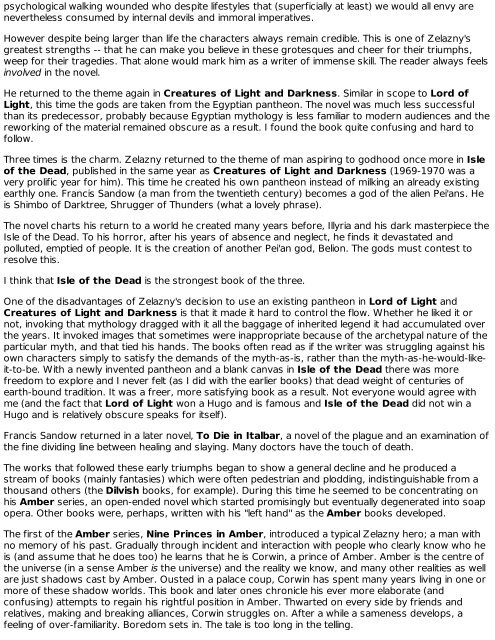Triffids Beard 2 - The Bearded Triffid
Triffids Beard 2 - The Bearded Triffid
Triffids Beard 2 - The Bearded Triffid
Create successful ePaper yourself
Turn your PDF publications into a flip-book with our unique Google optimized e-Paper software.
psychological walking wounded who despite lifestyles that (superficially at least) we would all envy are<br />
nevertheless consumed by internal devils and immoral imperatives.<br />
However despite being larger than life the characters always remain credible. This is one of Zelazny's<br />
greatest strengths -- that he can make you believe in these grotesques and cheer for their triumphs,<br />
weep for their tragedies. That alone would mark him as a writer of immense skill. <strong>The</strong> reader always feels<br />
involved in the novel.<br />
He returned to the theme again in Creatures of Light and Darkness. Similar in scope to Lord of<br />
Light, this time the gods are taken from the Egyptian pantheon. <strong>The</strong> novel was much less successful<br />
than its predecessor, probably because Egyptian mythology is less familiar to modern audiences and the<br />
reworking of the material remained obscure as a result. I found the book quite confusing and hard to<br />
follow.<br />
Three times is the charm. Zelazny returned to the theme of man aspiring to godhood once more in Isle<br />
of the Dead, published in the same year as Creatures of Light and Darkness (1969-1970 was a<br />
very prolific year for him). This time he created his own pantheon instead of milking an already existing<br />
earthly one. Francis Sandow (a man from the twentieth century) becomes a god of the alien Pei'ans. He<br />
is Shimbo of Darktree, Shrugger of Thunders (what a lovely phrase).<br />
<strong>The</strong> novel charts his return to a world he created many years before, Illyria and his dark masterpiece the<br />
Isle of the Dead. To his horror, after his years of absence and neglect, he finds it devastated and<br />
polluted, emptied of people. It is the creation of another Pei'an god, Belion. <strong>The</strong> gods must contest to<br />
resolve this.<br />
I think that Isle of the Dead is the strongest book of the three.<br />
One of the disadvantages of Zelazny's decision to use an existing pantheon in Lord of Light and<br />
Creatures of Light and Darkness is that it made it hard to control the flow. Whether he liked it or<br />
not, invoking that mythology dragged with it all the baggage of inherited legend it had accumulated over<br />
the years. It invoked images that sometimes were inappropriate because of the archetypal nature of the<br />
particular myth, and that tied his hands. <strong>The</strong> books often read as if the writer was struggling against his<br />
own characters simply to satisfy the demands of the myth-as-is, rather than the myth-as-he-would-likeit-to-be.<br />
With a newly invented pantheon and a blank canvas in Isle of the Dead there was more<br />
freedom to explore and I never felt (as I did with the earlier books) that dead weight of centuries of<br />
earth-bound tradition. It was a freer, more satisfying book as a result. Not everyone would agree with<br />
me (and the fact that Lord of Light won a Hugo and is famous and Isle of the Dead did not win a<br />
Hugo and is relatively obscure speaks for itself).<br />
Francis Sandow returned in a later novel, To Die in Italbar, a novel of the plague and an examination of<br />
the fine dividing line between healing and slaying. Many doctors have the touch of death.<br />
<strong>The</strong> works that followed these early triumphs began to show a general decline and he produced a<br />
stream of books (mainly fantasies) which were often pedestrian and plodding, indistinguishable from a<br />
thousand others (the Dilvish books, for example). During this time he seemed to be concentrating on<br />
his Amber series, an open-ended novel which started promisingly but eventually degenerated into soap<br />
opera. Other books were, perhaps, written with his "left hand" as the Amber books developed.<br />
<strong>The</strong> first of the Amber series, Nine Princes in Amber, introduced a typical Zelazny hero; a man with<br />
no memory of his past. Gradually through incident and interaction with people who clearly know who he<br />
is (and assume that he does too) he learns that he is Corwin, a prince of Amber. Amber is the centre of<br />
the universe (in a sense Amber is the universe) and the reality we know, and many other realities as well<br />
are just shadows cast by Amber. Ousted in a palace coup, Corwin has spent many years living in one or<br />
more of these shadow worlds. This book and later ones chronicle his ever more elaborate (and<br />
confusing) attempts to regain his rightful position in Amber. Thwarted on every side by friends and<br />
relatives, making and breaking alliances, Corwin struggles on. After a while a sameness develops, a<br />
feeling of over-familiarity. Boredom sets in. <strong>The</strong> tale is too long in the telling.


